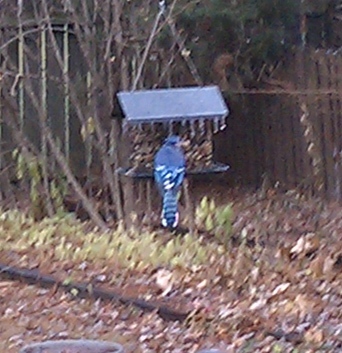 After ten years of working on the BlueJ project, today, for the first time, I saw a real-life Bluejay. Out in the wild. Outside the window, just a few metres away, on the bird feeder.
After ten years of working on the BlueJ project, today, for the first time, I saw a real-life Bluejay. Out in the wild. Outside the window, just a few metres away, on the bird feeder.
Very exciting.

We are very happy to hear that Greenfoot was awarded the 2010 Premier Award for Excellence in Engineering Education Courseware, a prize given to systems that show “high-quality, engaging, non-commercial learning innovations designed to enhance engineering education.”
Two systems are chosen annually by Engineering Pathway to receive the Premier Award, a prize that marks outstanding contributions in engineering software. Ian and Davin from our team made the trip to the Frontiers in Education Conference in Washington, D.C., to receive the award at a special “Premier Award Ceremony”.
This is the second award that Greenfoot has received (after winning the Duke’s Choice Award in 2007). But, of course, we don’t do all this for the awards. We just do it for all the the fame and money…
 Earlier today I wrote about the new Greenfoot features. I forgot one: Saving the world.
Earlier today I wrote about the new Greenfoot features. I forgot one: Saving the world.
In previous editions of Greenfoot, there was one annoying aspect: every time you had to recompile your classes, your interactively created objects disappeared. (This was not a bug: it is necessary, because the class implementing these objects does not exist anymore.)
This could be overcome by writing an initialiser method in the world class that creates and inserts all the objects you want to have in the world. This solves the problems, since objects get recreated automatically. However, writing these initialiser methods can be tedious.
So we come to the rescue: Saving the World.
You can now insert the objects you initially want in the world interactively, and then save the visible state of the world as the starting state of your program. Let’s look at an example.
Let us assume I want a scenario where the initial objects at the start of the game are a hamburger and three pigs. (Don’t ask). Let us further assume that I have just created the pigs and the hamburger interactively and placed them into my world. Figure 1 shows my world at this stage.
This is all well so far – with the problem that the actors will disappear (and I have to manually recreate them) after every compile.
Enter Save the World.
In Greenfoot 2.0, I can now select Save the World from the world context menu (Figure 2).
When I choose this function, Greenfoot writes the source code for a method called “prepare” into the class of the world object. This method contains code to create and insert objects just as they are in the world, and a call to this method from the world constructor (Figure 3).
The effect is that next time, when I recompile my class and the world is re-created, the objects in the world are re-created as well. The status of the world is saved.
There are a few characteristics worth noting about this mechanism:
(All screenshots in this post are produced by the author and are hereby placed in the public domain.)
Yes! It’s here! It’s out!
Greenfoot 2.0 has just been released. After a lot of hard work, and about a month behind schedule, we finally completed the work on Greenfoot 2.0. Even though it may not be immediately obvious, this is one of the largest updates we have ever produced for Greenfoot. A lot of work has been done internally, and users will discover the effects of many of them over time.
New features are available in the editor, for processing and recording sound, for editing images, debugging your programs, and more. Here, I will summarise the most interesting changes (at least those that users can directly see – there are many internal improvements to performance and stability that I won’t discuss here).
The first thing users will notice after upgrading is a new splash screen. (Yes, we are now supported by the good folks at Oracle, instead of Sun Microsystems, after Sun was swallowed up by Oracle.)
But after that, it all might look rather underwhelming at first. The Greenfoot main window looks pretty much as it used to look before. “Where’s the new stuff?”, I hear you ask. Sharp-eyed users may notice one small change: the world name, that used to be shown above the world in the main window, is not there anymore.
The name of the world used to serve as a placeholder to represent the world object itself. It had a right-click functionality, that let you access the world object’s context menu to invoke instance methods on the world object itself. The problem was that this functionality was quite hidden, and many users never discovered it. It was bad UI design, since nothing in the name indicated that this was clickable. It had, in fact, almost easter egg-like quality.
We have now removed this name, and instead made the whole world area right-clickable. Right-clicking the world itself (or indeed the grey background behind it) will show the world object context menu and lets you invoke the world methods.
Right-clicking in the world itself is more natural (more conforming to user expectations and more discoverable) and we expect that users will find this menu more easily now. (By the way, the reason that this was not done like this in the first place is that early versions of Greenfoot had different functionality attached to mouse clicks in the world.)
The next thing many users will discover is the new look of the editor.
The new editor
Greenfoot now incorporates the same editor that is used in BlueJ since the BlueJ 3.0 release earlier this year. The new features include scope highlighting, a new navigation view, better Find and Replace and code completion. (Code completion is activated by pressing Ctrl-Space.) I have described these features in more detail in an earlier blog post, when they came out with BlueJ – read them there if you want to know more..
We expect that the new editor, especially the availability of code completion for Greenfoot API calls, will be a substantial improvement to the user experience. (I have been using it for a few months now, and I wouldn’t want to work without it anymore!)
Sound recording
Greenfoot now has a built-in sound recorder. It can be found in the Controls menu, and you can now record your sounds directly from within Greenfoot. The functionality is very simple — just recording and trimming is supported — but this is what you need most of the time. If you want more sophisticated sound editing, you can still use third party applications (such as Audacity). However, the built-in recorder should be sufficient in many cases.
There is unfortunately a Java bug that cases problems with sound recording on some USB connected microphones. It works, however, with most microphones, and we hope that the remaining problems will be fixed in a future Java update.
But sound recording is not all that’s new with sound. You now also have more control over sound playback.
MP3 support
Yes, mp3 support! Greenfoot can now play mp3 files! Really. So go on and write your first MP3 player.
The GreenfootSound class
In previous Greenfoot versions, programmers had little control over how sounds are played. They could be started, but that’s all. Now, Greenfoot has a new class called GreenfootSound. It has method for starting, stopping and pausing sounds, as well as looping. This makes working with sounds much more flexible.
For short, simple sounds (such as sound effects), the Greenfoot.playSound(…) method is still the best to be used. But if you need more sophisticated functionality, create a GreenfootSound object and you can control the sound in more detail.
The debugger
Greenfoot now has a debugger built in. As some of you had discovered before, the code for the debugger has been there under the hood for some time (and there were ways to make it come up), but it was not working well, not supported, not finished, and had no proper interface.
Now you can open the debugger window from the menu, set breakpoints, stop the execution, single step through your programs and monitor your variable values. Especially for illustrating the working of control structures, this should be a useful help.
Image editing
Creating or editing images is a task that is very often part of developing Greenfoot scenarios. Now you can start creating or editing images directly from within the Greenfoot image dialogue.
The action menu under the image list offers functions to edit, delete or create an image. This will happen in external applications. By default, Greenfoot will open the default application for the chosen file type on any platform. This behaviour can also be configured to select a specific application. (I will write in more detail about some of these new functions in separate posts soon – I’ll discuss how to do this then.)
When images are created, they are automatically placed into the scenario’s images folder, so that they are immediately available for use in Greenfoot.
Unbounded worlds
The last bit of functionality I’ll talk about today are unbounded worlds.
As you know (if you have used Greenfoot in the past), actors cannot leave the world. When they try to move beyond world boundaries they are simply placed at the edge of the world. Breaking out is impossible for them. This has good reason: if actors were to leave the visible world, it can be very hard to get them back. You cannot interact with them anymore, and you don’t really know where they are. In fact, you may not even be aware that they are still there. This has great potential of confusion and difficulty for beginners.
This behaviour remains the default in Greenfoot 2.0 — but you can now configure your world to allow actors to leave the visible area for specific scenarios, should you want to do that. (And we know that some of you do: many of you have asked for this for some time!)
The world is then essentially infinite in all directions, and the visible world in the Greenfoot window is just a viewport into a small part of this eternal universe.
The World superclass now has a second constructor that allows the bounds to be removed:
| Constructor Summary | |
|---|---|
World(int worldWidth, int worldHeight, int cellSize)Construct a new world. |
|
World(int worldWidth, int worldHeight, int cellSize, boolean bounded)Construct a new world. |
|
The first constructor is as before. Thus, you old code will work unchanged. For example, a world constructor
public AntWorld() { super(500, 400, 1); }
will work as before and create the usual bounded world. However, you can now also use
public AntWorld() { super(500, 400, 1, false); }
In this case, actors will be allowed to leave the visible world and walk as far away as they like. For some type of games this will be very useful. When out of the visible world, they will still act, cause collisions, etc. You just cannot see them.
And so…
So, plenty of new stuff in Greenfoot 2. The last thing to tell you is where to get it. And that is, of course, where it has always been: www.greenfoot.org.
Install it, take it for a spin, and let us know what you think. We’d love to get your feedback. Bug reports, of course, but also things you like. You comments are one of the inputs that drive our future development.
And most of all, as always: Have fun programming!
I forgot to mention one new feature: Saving the world. I have now described this in a separate blog post.
 In a bold attempt to keep up with the times, and trying to not appear to be the bunch of old dinosaurs which we actually are (in internet age, at least), Greenfoot is now on Twitter.
In a bold attempt to keep up with the times, and trying to not appear to be the bunch of old dinosaurs which we actually are (in internet age, at least), Greenfoot is now on Twitter.
None of us really knows very much about this, but apparently this is what one does nowadays. So now you have the unique chance to follow the GreenfootTeam and find out first hand why releases are delayed, bugs pop up, and how software somehow still gets released eventually.
 Do you remember the feeling when you were a kid and you had the fantastically rare chance to go into a sweet shop (or, as the Americans among us would probably say: candy store), and you actually had a bit of money, and you could buy something, and there was just so much choice? Wow.
Do you remember the feeling when you were a kid and you had the fantastically rare chance to go into a sweet shop (or, as the Americans among us would probably say: candy store), and you actually had a bit of money, and you could buy something, and there was just so much choice? Wow.
(I still get a similar feeling now – not so much with candy, but with chocolates. Hmmm, chocolate…)
This is what it seems like with educational programming software. Some ten years ago there was not very much around (at least not much that was in widespread use and had good resources), and now there is plenty. For a teacher of introductory programming, it’s a bit like being the kid in the sweet shop: So much here to look at, so much good stuff. But so hard to choose!
If you haven’t used any of the current educational programming environments before, it’s hard to get your head around what’s in them. Just like the well known box-of-chocolates problem. When I talk about Greenfoot, I often get the question “How does it compare to Scratch?” or “How is it different from Alice?”
To help a little with that situation, we organised a panel session at the last SIGCSE conference called Comparing Alice, Greenfoot and Scratch which compared these three environments. “We”, in this context, were Sally Fincher and Ian Utting who organised the session, and Steve Cooper (Alice), John Maloney (Scratch) and myself (Greenfoot) presenting the environments. I really enjoyed the session – it was great to get one of the leading people involved in each of the development teams to present the environments, and it was well received: the room was packed full and the feedback was good.
But panels are transient – no good record is available for those who were not there. So we are now working on a series of articles for a special issue of the Transactions on Computing Education doing the same in writing. They should be published together in a single issue later this year, and include a paper on each of the three environments and a discussion section where we talk about commonalities and differences.
To read it, you have to wait until it comes out. But as a teaser, here is a graphic that we made for the papers, showing the target age groups for each of the three systems.
Maybe this answers one of your questions already. For everything else, you’ll have to wait a little longer.
A couple of days ago I received an email calling for workshop proposals for SIGCSE 2011.
I have given Greenfoot workshops there for the past few years (and BlueJ workshops before that). Now I am wondering whether I should do the same again.
I am definitely planning to propose a Greenfoot workshop, but I am uncertain about the level that I should aim at. Should I do the same beginners’ workshop (for people who haven’t seen Greenfoot before) or is it maybe time to do an advanced one to help people move forward who have seen the basics of Greenfoot?
I just received the feedback from this year’s workshop, and it was certainly popular. I got really nice, very positive comments (someone wrote “This was exactly the “killer app” that I had hoped to run across at this conference” – thanks!). So that workshop works well as it is. And the fact is without a doubt that the majority of participants at SIGCSE do not know Greenfoot.
On the other hand, we want to support our users. Teachers who have adopted Greenfoot in the past couple of years might like some further tips and opportunity for discussion.
At this stage I am undecided. I will have to make my mind up in the next couple of weeks. If you have an opinion – let me know.
 I have just reached the end of the first week of teaching here in Berlin, at the “Institut für Informatik“, part of the Freie Universität Berlin.
I have just reached the end of the first week of teaching here in Berlin, at the “Institut für Informatik“, part of the Freie Universität Berlin.
I am teaching a module called ProInformatik III: Objektorientierte Programmierung – a block course that runs every day with five hours of contact over four weeks.
So, what have I learned so far?
Apart from the fact that translating technical terms into German poses regular challenges (what’s the German word for Debugger?), that apparently my German sounds funny now (well, 18 years out of Germany have left their marks…) and that I can still use a blackboard with chalk (we had a power-out yesterday), one of the most interesting observations is that the students here are much more talkative, more engaged, and ask much more interesting questions than my students at home. Where does that come from?
Well, partly this comparison is unfair. This is a summer course that students can take as a taster before they start to study. If they pass it, and then enrol in the degree programme, they get full credit. This naturally leads to a selective audience. I would guess that it is much more likely that the well-motivated, organised, keen (and possible good) students participate in these voluntary summer courses, so I’m dealing with a subset that is probably easier to teach.
However, I wonder whether there is also another factor at work. In Germany – compared to UK – school starts a year later, and lasts a year longer (although that is just changing now, with most states in Germany changing from 13 years to 12 years of schooling). That means students enter university two years later.
Add to this the fact that Germany has compulsory military service (for males only) we get a situation – in this male dominated discipline – where many of our students are three years older than their UK counterparts.
In other words: Many start here at an age where UK students finish.
The effect is startling. Instead of dealing with kids, I’m dealing with young adults. I wonder whether another year of life before study wouldn’t be a good thing for UK students as well.
The Greenfoot book, which teaches Java programming and object orientation with the Greenfoot environment, is now available in German (as well as the original English).
That’s great news: Germany is probably the country with most Greenfoot users outside the English speaking world, and having the book in German will make use of the book – be it adoption in the classroom or casual reading by hobbyists – much easier.
I have just received my copy, and it looks great. The publisher has done a great job with full colour printing and good quality paper.
The translation is great, too – it was done by Carsten Schulte from the Freie Universität Berlin. I was really lucky that the publisher found such an excellent translator. It shows that he’s a computer scientist and an educator as well. His deep understanding of the concepts has clearly led to a much better translation than someone without subject knowledge could have produced.
I’m happy to see it out, and to see it end up looking this nice.
A few days ago, the Royal Society has announced a study on the state of computing education in UK schools, its problems and possible solutions. This has been quite widely reported in the press, for example here. The announcement itself makes for interesting reading. Its introduction starts:
Numbers of students studying computing are plummeting across the UK, with a fall of 33% in just three years in ICT GCSE students, a fall of 33% in six years in A level ICT and 57% in eight years in A level Computing students in England and similar declines found elsewhere in the UK.
It contains some good quotes from a range of people, such as this by Matthew Harrison, Director of Education at The Royal Academy of Engineering
“Young people have huge appetites for the computing devices they use outside of school. Yet ICT and Computer Science in school seem to turn these young people off. We need school curricula to engage them better if the next generation are to engineer technology and not just consume it.”
This is the latest development in a growing trend in the UK that recognises the dismal state of computer science education in UK schools, and starts to work on finding solutions. I became involved in this topic a couple of years ago, through the Computing At Schools (CAS) group, a fantastic movement of really motivated and smart individuals initiated by Simon Peyton-Jones. This has grown over the years with initiatives such as developing curriculum for schools, organising computing teacher conferences, and founding a computing teachers association.
While the announcement of the study contains little new to those who already had an interest in the topic, it’s great to see that the Royal Society is getting interested and getting involved. This helps getting more organisations on board with making a change (already apparent from the announcement) and will push the issue higher on the agenda of those who are in the position to make decisions.
There is no doubt at all in my mind that such change is urgently needed and important. Currently, there is a whole generation of kids, some of whom would make great and enthusiastic computer scientists, who never find out about the possibilities and joys of this exciting discipline.
Altogether a great development.